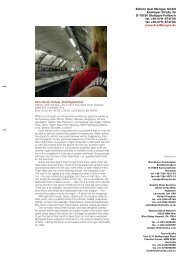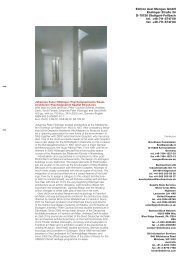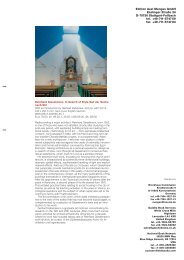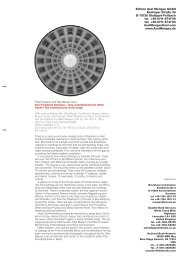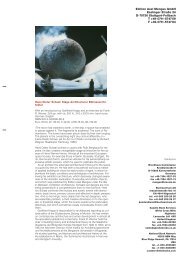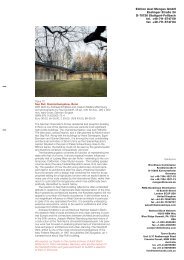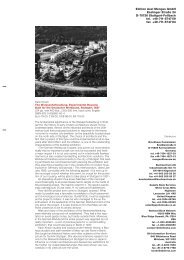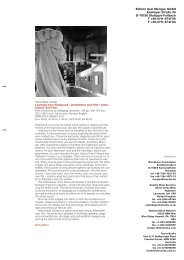Bruno Paul - Edition Axel Menges
Bruno Paul - Edition Axel Menges
Bruno Paul - Edition Axel Menges
You also want an ePaper? Increase the reach of your titles
YUMPU automatically turns print PDFs into web optimized ePapers that Google loves.
At the dawn of the 20th century, <strong>Bruno</strong> <strong>Paul</strong> (1874–1968) stood like a colossus astride<br />
the landscape of an emerging Modernism. As an illustrator, architect and educator his<br />
influence was unequalled. Arguably the most important German designer of his generation,<br />
his work was ubiquitous in the technical and professional publications of his<br />
day. For five decades, <strong>Paul</strong>’s reputation was unparalleled among progressive German<br />
artists. As a young man he was a member of the Munich avant-garde responsible for<br />
the creation of the Jugendstil. As a designer of furniture and interiors, he achieved a<br />
commercial success unmatched by his illustrious contemporaries. In the light of his<br />
professional accomplishments, he was the most influential German architect of his<br />
generation, a figure of international significance. Ludwig Mies van der Rohe, Adolf<br />
Meyer and Kem Weber were among his students, and their work developed from the<br />
practices of his atelier. Indeed, as director of the Vereinigte Staatsschulen für freie<br />
und angewandte Kunst in Berlin he presided over an institution that rivaled the Bauhaus<br />
as a center of progressive instruction in the arts.<br />
069.00 Euro<br />
108.00 sfr<br />
048.00 £<br />
079.00 US $<br />
128.00 $A<br />
ISBN 3-932565-47-9<br />
9 783932 565472<br />
57900<br />
William Owen Harrod <strong>Bruno</strong> <strong>Paul</strong> <strong>Menges</strong><br />
William Owen Harrod<br />
<strong>Bruno</strong> <strong>Paul</strong><br />
The Life and Work<br />
of a Pragmatic Modernist<br />
At the dawn of the 20th century, <strong>Bruno</strong> <strong>Paul</strong><br />
(1874–1968) stood like a colossus astride the landscape<br />
of an emerging Modernism. As an illustrator,<br />
architect and educator his influence was unequalled.<br />
Arguably the most important German<br />
designer of his generation, his work was ubiquitous<br />
in the technical and professional publications<br />
of his day. For five decades, <strong>Paul</strong>’s reputation was<br />
unparalleled among progressive German artists.<br />
As a young man he was a member of the Munich<br />
avant-garde responsible for the creation of the<br />
Jugendstil. As a designer of furniture and interiors,<br />
he achieved a commercial success unmatched<br />
by his illustrious contemporaries. In the<br />
light of his professional accomplishments, he was<br />
the most influential German architect of his generation,<br />
a figure of international significance. Ludwig<br />
Mies van der Rohe, Adolf Meyer and Kem Weber<br />
were among his students, and their work developed<br />
from the practices of his atelier. Indeed, as<br />
director of the Vereinigte Staatsschulen für freie<br />
und angewandte Kunst in Berlin he presided over<br />
an institution that rivaled the Bauhaus as a center<br />
of progressive instruction in the arts.<br />
Despite the renown he enjoyed at the height<br />
of his career, <strong>Paul</strong>’s name has been largely absent<br />
from the standard histories of the modern movement.<br />
Indeed, this book is the first comprehensive<br />
study of his life and work. Nevertheless, <strong>Paul</strong>’s<br />
story embodies a significant facet of the history<br />
of 20th-century design: the development of Modernism<br />
in Central Europe and its coalescence from<br />
the influences of Jugendstil, Elementarism, Classicism,<br />
Expressionism and Functionalism. <strong>Paul</strong><br />
played a prominent role in this coalescence, and<br />
he deserves a place of honor in the history of the<br />
modern movement. Yet his biography also encompasses<br />
a less familiar, but no less significant, aspect<br />
of the history of modern design. It cupied a<br />
middle ground between avant-garde experimentation<br />
and conservative professional practice, a<br />
Modernism that was timeless, practical and principled.<br />
It was this pragmatic Modernism that won<br />
the patronage of the middle classes and established<br />
progressive design as an accepted alternative,<br />
and eventually as the preferred alternative to<br />
the period styles. Moreover <strong>Paul</strong>’s pragmatic Modernism,<br />
and its underlying principles, remain as<br />
relevant today as when they were first conceived.<br />
William Owen Harrod is a graduate of the Massachusetts<br />
Institute of Technology and the University<br />
of Texas at Austin, where he received his doctorate<br />
in architectural history. He is a practicing architect,<br />
theoretician and historian, based in Austin,<br />
Texas.




